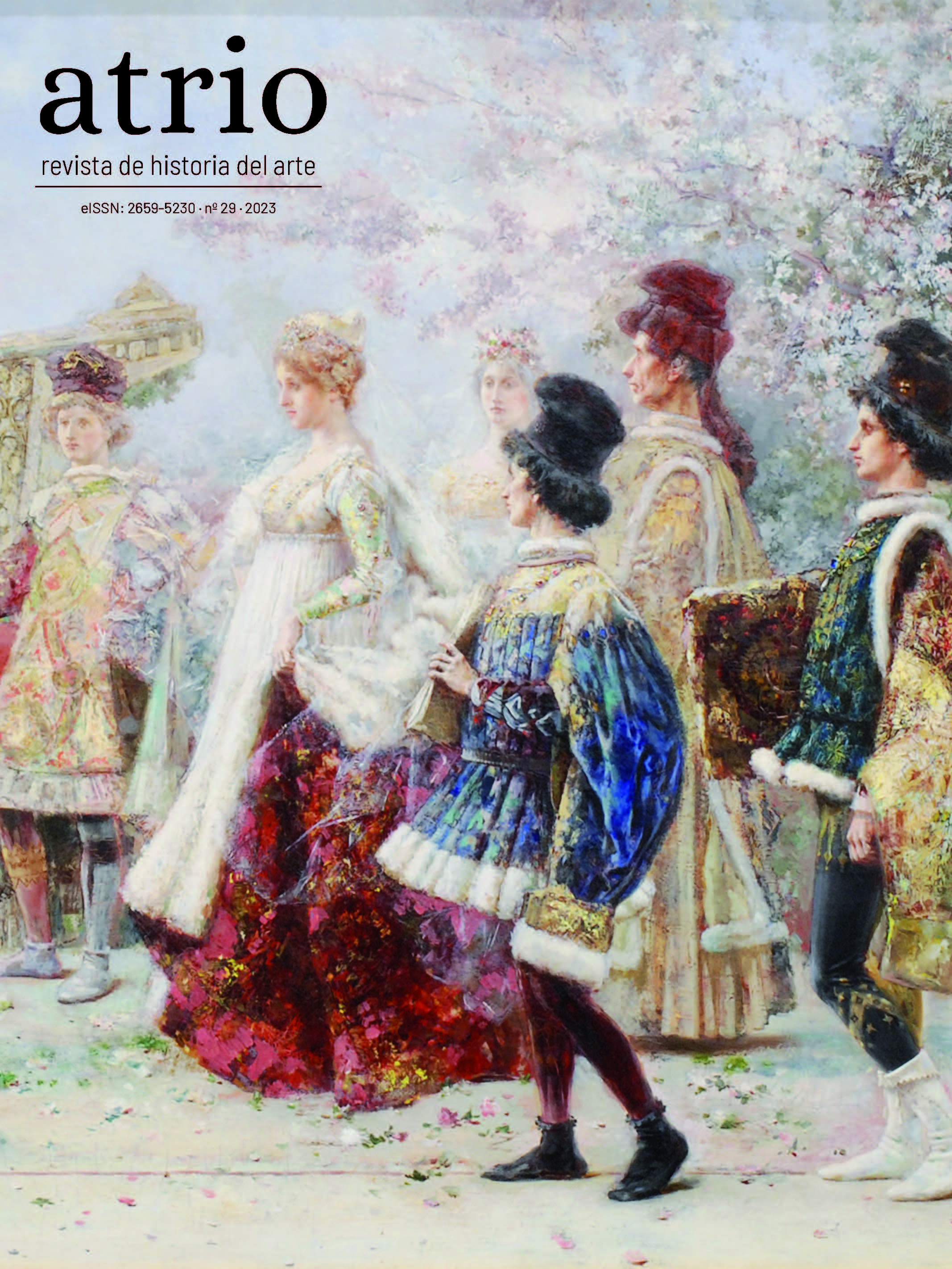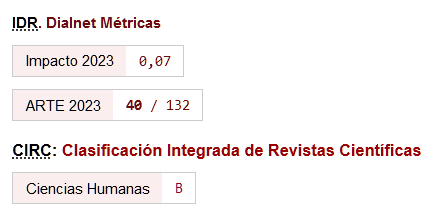On the Gesture χεῖρ’ ἐπί καρπῶ in Etruscan and Faliscan Visual Culture.
DOI:
https://doi.org/10.46661/atrio.7829Keywords:
χεῖρ’ ἐπί καρπῶ, Wrist-Grasping Gesture, Gestuality, Offering, Etruscan and Faliscan Visual Culture, Etruscan Funerary WorldAbstract
Around the first half of the 6th century BC, Etruscan visual culture appropriated a gesture of Egyptian origin but characteristic of Greek art called χεῖρ’ ἐπί καρπῶ (to grab the wrist) and, over the coming centuries, it was adapted and, on some occasions, even reinterpreted, granting it, in this way, a semantic meaning different from the original. Thus, the objective of this study is, on the one hand, to present a brief overview of the most characteristic Etruscan and Faliscan visual examples in which said gesture is identified and, on the other hand, to expose the multiple readings it acquires according to the visual narrative, although, among them, we can anticipate that the funerary is the main one feature.
Downloads
References
Fuentes bibliográficas:
Akurgal, Ekrem. The Art of Grecce: Its Origins in the Mediterranean and Near East. New York: Crown Publishers, 1968.
Baggio, Monica. I gesti della seduzione: Tracce di comunicazione non-verbale nella ceramica greca tra VI e IV secolo a.C. Roma: L’Erma di Bretschneider, 2003.
Briquel, Dominique. “Sur les faux miroirs étrusques avec enlèvement de Thétis par Pélée.” Ocnus, no. 29 (2021): 41-57.
Boegehold, Alan Lindley. When a gesture was expected: A selection of examples from archaic and classical Greek literature. Princenton: Princenton University Press, 1999.
Bonamici, Marisa. “Lo stamnos di Vienna 448: una proposta di lettura.” Prospettiva, no. 89/90 (1998): 2-15.
Bonfante, Larissa. Etruscan life and afterlife: A handbook of Etruscan studies. Detroit: Wayne State University Press, 1986.
Cabrera Bonet, Paloma. “Orfeo en los Infiernos. Imágenes apulias del destino del alma.” Ilu. Revista de Ciencias de las Religiones, no. 23 (2018): 31-56. https://doi.org/10.5209/ILUR.61020.
Da Vela, Raffaella. “Equilibrio e movimiento del corpo in alcuni rilievi chiusini di età arcaica e subarcaica.” En L’arte e la produzione artigianale in Etruria, editado por la Scuola di Etruscologia e archeologia dell’Italia Antica, 141-187. Roma: Quasar, 2006.
De Angelis, Francesco. “Il destino di Hasti Afunei: Donne e famiglia nell’epigrafia sepolcrale di Chiusi.” En L’écriture et l’espace de la mort: épigraphie et nécropoles à l’époque préromaine, dirigido por Marie-Laurence Haack, 419-459. Rome: École Française de Rome, 2016. https://doi.org/10.4000/books.efr.2765.
De Puma, Richard Daniel. Etruscan art in the Metropolitan Museum of Art. New York: Metropolitan Museum of Art, 2013.
Gerhard, Eduard. Etruskische Spiegel. Roma: Ed. Ardita, 1965.
Govi, Elisabetta. “Lo studio delle stele Felsinee. Approccio metodológico e analisi del linguaggio figurativo.” En Artisti, committenti e fruitori in Etruria tra VIII e V secolo a.C., editado por Giuseppe M. Della Fina, 127-186. Roma: Quasar, 2014.
Harrison, Evelyn B. “Motifs of the City-Siege on the Shield of Athena Parthenos.” American Journal of Archaeology, no. 85.3 (1981): 281-317. https://doi.org/10.2307/504171.
Huber, Ingeborg. Die Ikonographie der Trauer in der griechischen Kunst. Mannheim; Möhnesee: Bibliopolis, 2001.
Jackson-Martin, Rafael, y Jorge Tomás García. “Hijos de Endimión: memoria gestual, desnudos y géneros del mundo antiguo a la cultura visual contemporánea.” En En los márgenes del mito. Hibridaciones de la mitología clásica en la cultura de masas contemporánea, editado por Luis Unceta Gómez y Helena González Vaquerizo, 129-160. Madrid: Catarata - UAM Ediciones, 2002.
Jannot, Jean-René. Les reliefs archaïques de Chiusi. Roma: Ecole Française de Rome, 1984.
Krauskopf, Ingrid. “The Grave and Beyond in Etruscan Religion.” En The Religion of the Etruscans, editado por Nancy Thomson de Grummond y Erika Simon, 66-89. Austin: University of Texas Press, 2006. https://doi.org/10.7560/706873-009.
Kunstwerke der Antike: Auktion 70. Antike Gläser. Griechische, etruskische und römische Bronzen (Sammlung SUTER, Basel). Schmuck der Antike. Griechische Vasen. Etrurien-Griechenland-Unteritalien (Nachlass Dr. Ferruccio BOLLA, Lugano). 14. November 1986. Basel: Münzen und Medaillen AG, 1986.
Maggiani, Adriano. “Qualche osservazione sul fegato di Piacenza.” Studi Etruschi, no. 50 (1982): 53-88.
Martinelli, Maurizio. Religione e riti in Etruria. Roma: Arbor Sapientia, 2017.
McNiven, Timothy John. Behaving like a child: Immature gestures in Athenian Vase Painting. Princenton; New Jersey: The American School of Classical Studies, 2007.
McNiven, Timothy John. Gestures in Attic vase painting: Use and meaning, 550 - 450 B.C. Ann Arbor: UMI, 1989.
Naso, Alessandro. “Caratteri distintivi delle élites arcaiche nell’Italia preromana.” En Ascesa e crisi delle aristocrazie arcaiche in Etruria e nell’Italia preromana. Atti del XXVII Convegno Internazionale di Studi sulla Storia e l’Archeologia dell’Etruria, editado por Giuseppe M. della Fina, 129-177. Roma: Quasar, 2020.
Neumann, Gerhard, Gesten und Gebärden in der Griechischen Kunst. Berlin: de Gruyter, 1965. https://doi.org/10.1515/9783110856606.
Oakley, John Howard, y Rebecca H. Sinos. The Wedding in Ancient Athens. Madison: University of Wisconsin Press, 1993.
Ochoa Soto, Igor “La iconografía del difunto en Etruria: símbolos y espacios de transformación (siglos iv-ii a. C.).” En Abantos: Homenaje a Paloma Cabrera Bonet, editado por Andrés Carretero Pérez, Maribel Castellano, Margarita Moreno Conde y Concha Papí Rodes, 743-750. Madrid: Ministerio de Cultura y Deporte, 2021.
Panofsky, Erwin, Estudios sobre iconología. Madrid: Alianza, 1972.
Paschinger, Elfriede. “Die Etruskische Todesgöttin Vanth.” Antike Welt, no. 19.1 (1988): 39-45.
Pedrina, Marta. I gesti del dolore nella ceramica attica (VI-V secolo a.C.): Per un’analisi della comunicazione non verbale nel mondo greco. Venezia: Istituto veneto di scienze, lettere ed arti, 2001.
Pirenne-Delforge, Vinciane, y Gabriella Pironti. The Hera of Zeus: Intimate Enemy, Ultimate Spouse. Cambridge: Cambridge University Press, 2022. https://doi.org/10.1017/9781108888479.
Rallo, Antonia. Le donne in Etruria. Roma: Erma di Bretschneider, 1989.
Roncalli, Francesco. “La Tomba dei Giocolieri di Tarquinia: una proposta di lettura.” En Aeimnēstos: Miscellanea di studi per Mauro Cristofani, editado por Benedetta Adembri, 407-423. Firenze: Centro Di, 2006.
Roumpi, Antonia. “Χεῖρ ἐπὶ καρπῷ. The Samothracian frieze of dancing maidens revisited.” Imago Musicae, no. 21-22 (2004): 29-48.
Silver, Morris. Slave-wives, single women and “bastards” in the ancient Greek world: Law and economics perspectives. Oxford: Oxbow Books, 2018. https://doi.org/10.2307/j.ctv13pk84j.
Spinola, Giandomenico. “Vanth. Osservazioni iconografiche.” Rivista di Archeologia, no. 11 (1987): 56-67.
Steingräber, Stephan, y Rusell Stockman. Abundance of life: Etruscan wall painting. Los Angeles: J. Paul Getty Museum, 2006.
Tanabe, Tadashi. “Diffusion on the greek gesture of touching another’s chin with raised hand in the east.” En Parthica. Incontri di culture nel mondo antico, editado por Antonio Invernizzi, 81-94. Pisa; Roma: Fabrizio Serra Editore, 2010.
Taylor, Laurel. “Death on Display: ‘Breaking Bad’ with Etruscan funerary imagery.” En Breaking with Convention in Italian Art, editado por Julia C. Fischer, 7-25. Newcastle: Cambridge Scholars Publishing, 2014.
Taylor, Laurel. “Performing the Prothesis: Gender, Gesture, Ritual and Role on the Chiusine Reliefs from Archaic Etruria.” Etruscan Studies. Journal of the Etruscan Foundation, no. 17 (2014): 1-27. https://doi.org/10.1515/etst-2014-0007.
Thomson de Grummond, Nancy. Etruscan myth, sacred history and legend. Philadelphia: University of Pennsylvania Museum, 2006.
Vérilhac, Anne-Marie, y Claude Vial. Le marriage grec du vie siècle avant J.-C. a l’époque d’Auguste. Athens: Ecole Française d’Athènes, 1998.
Referencias webs:
Badp. “Beazley Archive Database Pottery.” Consultado el 1 de febrero de 2023. https://www.beazley.ox.ac.uk/pottery/default.htm.
Bertolami Fineart. “Bertolami. Casa de Subastas.” Consultado el 1 de febrero de 2023, https://bertolamifineart.com/.
Cgbc. “Catalogo Generale dei Beni Culturali.” Consultado el 1 de febrero de 2023. https://catalogo.beniculturali.it/.
Galerie Cahn. “Cahn. Casa de Subastas.” Consultado el 1 de febrero de 2023. https://www.cahn.ch/.
Limc Id. “Lexicon Iconographicum Mythologiae Classicae.” Consultado el 1 de febrero de 2023. https://weblimc.org/page/home.
Pandolfini. “Pandolfini. Casa de Subastas.” Consultado el 1 de febrero de 2023. https://www.pandolfini.it/it/index.asp.
Plektron. Fine Arts. “Important Etruscan calyx krater in six’s technique attributed to the Praxias Group.” Consultado el 1 de febrero de 2023. https://plektronfinearts.com/.
Published
How to Cite
Issue
Section
License
Copyright (c) 2023 David Vendrell Cabanillas

This work is licensed under a Creative Commons Attribution-NonCommercial-ShareAlike 4.0 International License.
Los autores/as que publican en Atrio. Revista de historia del arte están de acuerdo con los siguientes términos:
- Los autores/as conservan los derechos de autor y garantizan a la revista el derecho de ser la primera publicación del trabajo al igual que licenciado bajo una licencia de Creative Commons Attribution-NonCommercial-ShareAlike 4.0 International License que permite a otros compartir el trabajo con un reconocimiento de la autoría de este y la publicación inicial en esta revista.
- El autor/a o cedente del material que se entrega para su publicación autoriza a la revista para que publique, sin obligación alguna (económica o de otra naturaleza), el contenido del referido manual tanto en formato papel, como en digital, así como en cualquier otro medio. Esta cesión de uso del material entregado comprende todos los derechos necesarios para la publicación del material en la revista. Quedan garantizados, simultáneamente, los derechos morales del autor
- El autor/a o cedente es plenamente consciente y está de acuerdo con que todos o cualesquiera de los contenidos proporcionados, formarán una obra cuyo uso se cede a la revista para su publicación total o parcial.
- El autor/a o cedente garantiza ser el titular de los derechos de Propiedad Intelectual sobre los contenidos proporcionados, es decir, sobre el propio texto e imágenes/fotografías/obras fotográficas que se incorporan en su artículo.
- El autor/a o cedente asegura y garantiza: (i) que todo el material enviado a la revista cumple con las disposiciones legales aplicables; (ii) que la utilización de cualquier material protegido por derechos de autor y derechos personales en la concepción del material se encuentra regularizada; (iii) que obtuvo las licencias de derechos, permisos y autorizaciones necesarias para la ejecución del material, inclusive los derechos de imagen, si fueran aplicables; y (iv) que el material no viola derechos de terceros, incluyendo, sin limitarse a estos, los derechos de autor y derechos de las personas.
- El autor/a o cedente, exime a la revista de toda y cualquier responsabilidad con relación a la violación de derechos de autor, comprometiéndose a emplear todos sus esfuerzos para auxiliar a la revista en la defensa de cualquier acusación, medidas extrajudiciales y/o judiciales. Asimismo, asume el abono a la revista de cualquier cantidad o indemnización que esta tenga que abonar a terceros por el incumplimiento de estas obligaciones, ya sea por decisión judicial, arbitral y/o administrativa.













